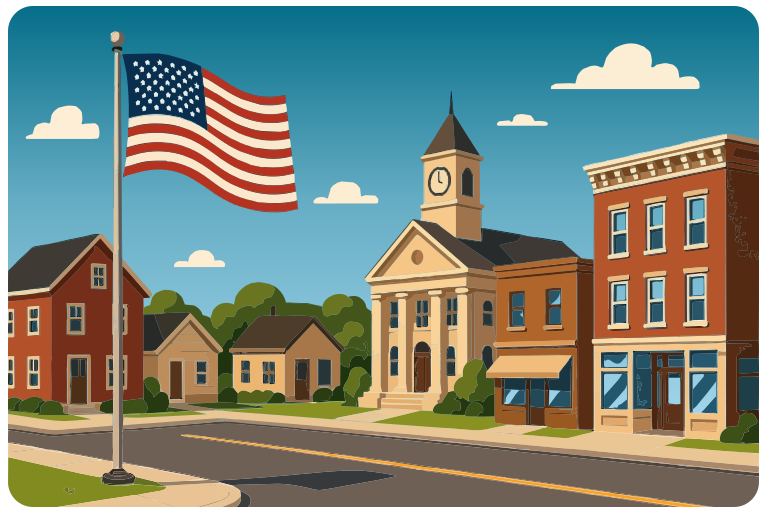Porque vs Por que: What’s the Difference?
Let’s settle this once and for all and see what's the difference between the four porques.
From gritty mill towns to mountain hideaways, this isn’t a tourist guide, it’s a map of America’s soul.

When we asked over 3,000 Americans to name the one town in their state that best reflects its culture – its soul, really – the responses painted a rich, sometimes surprising picture.
From beachy bohemia to gritty former mill towns, the results weren’t about where tourists flock.
They were about where locals feel at home. Looking through the full list of responses – not just the top picks, but the runners-up too – a few fascinating patterns emerged.
Despite the availability of major cities, respondents consistently gravitated toward lesser-known places.
Texas didn’t crown Austin, Houston, or Dallas – it gave the top spot to San Marcos, followed by Lockhart and Marfa.
Many of the towns named have rough edges – and that’s the point. Places like Butte (MT), Fall River (MA), and Zanesville (OH) reflect a working-class pride and layered history.
These aren’t “Instagram-perfect” destinations – they’re deeply lived-in, unapologetic, and proud of it.
Cities with strong ethnic or immigrant histories often ranked highly. Bayonne, NJ (with its deep Irish and Italian roots), and Fall River, MA (noted for Portuguese influence) both ranked near the top.
In Arizona, Bisbee, Flagstaff, Tuba City, Globe, and Sedona all made appearances – a spread that reflects the region’s Indigenous, mining, and arts-based histories.
The South, Midwest, and interior West saw repeated nominations for places that reflect rural rhythms: church, community, food, and family.
Towns like Dublin, GA; Cookeville, TN; Laurel, MS; and Ada, OK came up again and again. These are places where front porches still matter.
From Moab, UT and Livingston, MT to Leadville, CO and Ellensburg, WA – high-altitude, outdoorsy towns came up repeatedly.
Even Talkeetna, AK (a quirky rail town with 1,000 residents) made the list. These are places where identity is shaped by terrain as much as tradition.
Places like Wailuku, HI; Sitka, AK; Port Townsend, WA; and Apalachicola, FL all made the list – and they’re far more than surf spots.
These are maritime towns with deep traditions, tight-knit communities, and a slower, saltier pace of life.
Because the state was divided into NorCal, Central, and SoCal regions, we saw wildly different picks that reflect the state’s internal diversity.
Each region showed a distinct cultural flavor: SoCal leaned toward counterculture cool, Central went for wine towns and slow living, and NorCal leaned into artistic enclaves and small-town quirk.
This wasn’t just a list of travel recommendations. People weren’t picking the most famous, the flashiest, or the wealthiest towns – they picked the ones that feel right.
The ones where you hear the state’s accent, taste its cooking, and recognize its values at play in daily life.
The real language of a place isn’t always spoken in its capital – sometimes it’s found in a diner, a parade, or a porch swing halfway down Main Street.
Online panel survey of 3,012 respondents based on age, gender, and geography. Internal data sources are used to obtain population data sets. We used a two-step process to ensure representativeness through stratified sampling and post-stratification weighting.
Respondents are carefully chosen from a geographically representative online panel of double opt-in members. This selection is further tailored to meet the precise criteria required for each unique survey. Throughout the survey, we design questions to carefully screen and authenticate respondents, guaranteeing the alignment of the survey with the ideal participants.
To ensure the integrity of our data collection, we employ an array of data quality methods. Alongside conventional measures like digital fingerprinting, bot checks, geo-verification, and speeding detection, etc. each response undergoes a thorough review by a dedicated team member to ensure quality and contextual accuracy. Our commitment extends to open-ended responses, subjecting them to scrutiny for gibberish answers and plagiarism detection.

Let’s settle this once and for all and see what's the difference between the four porques.

Planning a trip to the Greek paradise? Here’s how to express gratitude in Greek.

Portuguese, whether Brazilian or European, is a beautiful and romantic language with its own unique charm. Which one is right for you?